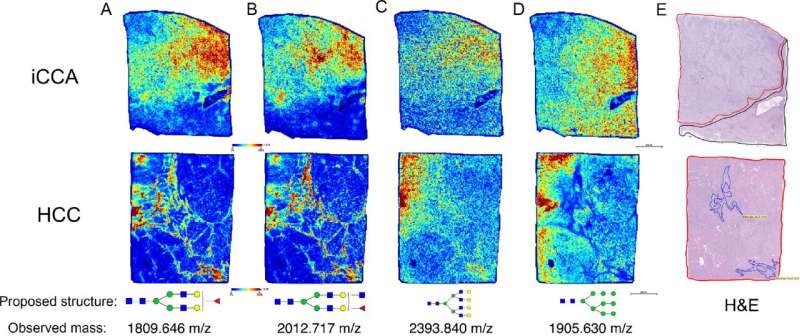This article has been reviewed according to Science X's editorial process and policies. Editors have highlighted the following attributes while ensuring the content's credibility:
fact-checked
trusted source
proofread
A better biomarker for an aggressive and fatal liver cancer

Finding cancer quickly is key in securing the best possible outcome for the patient.
An MUSC research team has found a way to make a lethal type of liver cancer more easily detectable. The team was led by Anand Mehta, D.Phil., Smart State Chair in Proteomic Biomarkers, and Shaaron Ochoa-Rios, Ph.D., who did her doctoral research in the Mehta lab. They report their findings in a recent issue of Cancer Research Communications.
Mehta and Ochoa-Rios identified a biomarker specific to intrahepatic cholangiocarcinoma (iCCA), a lethal type of liver cancer.
CCA is a subtype of the second most common type of liver cancer. It is aggressive and deadly and, if diagnosed late, has a five-year survival rate of only around 8%.
When caught early, however, the prognosis is much better. If the tumor is spotted in the early stages and surgically removed, the five-year survival rate soars to 50%.
"Early detection saves lives," said Mehta. "If you identify patients who have early-stage cancers, no matter what the cancer, they tend to have much longer survival time."
However, identifying CCA can be challenging.
The main symptoms of CCA—jaundice, itchy skin, fatigue and abdominal pain—are also common among other liver diseases. It is impossible to tell if people experiencing these symptoms have liver cancer or some other liver issue, said Ochoa-Rios.
Making matters worse, the number of liver cancer cases is likely to increase.
Historically, the 2- to 5 million people who develop liver cirrhosis are at the highest risk of developing liver cancer, said Mehta.
However, two other conditions, nonalcoholic fatty liver disease and nonalcoholic steatohepatitis, both associated with a high-fat diet and a sedentary lifestyle, are on the rise and put people at risk for developing liver cancer.
"Almost 100 million people fall into that category," Mehta said.
Given those numbers, it is not possible to put every single at-risk person through the battery of tests required to detect CCA, he said. Imaging tests are also time consuming, making their large-scale use impractical.
In situations like these, a specific and reliable biomarker is ideal.
Biomarkers
A biomarker is any noninvasive measurement that can be used to give care providers information about a patient's health. This could be anything from a blood pressure reading to the amount of a substance present in a person's blood.
The current biomarker used to detect CCA, CA 19-9, is not very specific, explained Ochoa-Rios.
"That same marker is also used to diagnose other types of liver conditions and even other types of cancers as well," she said.
Because a positive CA 19-9 test doesn't necessarily mean that a person has iCCA, he or she must also undergo general imaging tests such as MRI or CT scans. This battery of tests takes crucial time and can delay diagnosis and treatment.
Mehta and Ochoa-Rios found a biomarker specific to CCA that could help to speed up diagnosis.
"We believe we have identified a novel serum biomarker of CCA," said Mehta.
In tissue samples from patients with CCA, Mehta and Ochoa-Rios found certain changes to a type of sugar called N-glycan, which is found on proteins.
It is not known why these N-glycan changes occur, but they seem to occur consistently in tissue with CCA but not in healthy tissue or tissue with other types of liver cancer.
Mehta and Ochoa-Rios also found that they could see these N-glycan changes in blood samples. In fact, they could detect these N-glycan changes by looking at a blood sample just as well as they could by looking at tissue.
This means that these N-glycan changes in the blood function as a biomarker, allowing for the detection of CCA without the need for invasive tissue biopsy.
Additionally, unlike CA 19-9, this new biomarker can help to rule out other diseases.
"This biomarker can distinguish a patient who has cancer from a patient who has a very advanced stage of liver disease, such as cirrhosis," Ochoa-Rios said.
"The new N-glycan-based biomarker far exceeded the performance of the currently used biomarker," Mehta explained.
Going forward
Due to the way new biomarkers are rolled out for use in a clinical setting, it will be a while before this new biomarker is widely used. However, Mehta and Ochoa-Rios' efforts are a foundational step in this process.
The team plans to investigate further the N-glycan changes as well. N-glycans are attached to proteins. It will be important to understand which proteins are associated with N-glycan changes and why.
"We have no idea what proteins have this sugar, and we know historically that a better biomarker is when you have both pieces of information," said Mehta.
Both Mehta and Ochoa-Rios emphasized the need for a better biomarker for CCA as well as the promise of the N-glycan-based biomarker they found.
"I think as researchers, we are moving in the right direction," said Ochoa-Rios. "We are trying to address limitations that are present in the clinic."
"While there is still much work to be done, this is a good start, and we know what directions to take to find a good biomarker for CCA," said Mehta.
More information: Shaaron Ochoa-Rios et al, Analysis of N-linked Glycan Alterations in Tissue and Serum Reveals Promising Biomarkers for Intrahepatic Cholangiocarcinoma, Cancer Research Communications (2023). DOI: 10.1158/2767-9764.CRC-22-0422




















